#diverse student activities
Explore tagged Tumblr posts
Text
Hilltop School's Jamboree 2024 Concludes with Student Talent Showcase
Two-day event features diverse competitions and culinary delights for UKG to Class 12 Hill Top School’s Jamboree 2024 ended on Saturday, showcasing a wide range of student talents across various competitions and activities. JAMSHEDPUR – Hill Top School successfully concluded its two-day Jamboree 2024 on Saturday, featuring diverse competitions and culinary experiences for students from UKG to…
#शिक्षा#culinary experiences at school events#diverse student activities#education#Hill Top School Jamboree 2024#Jamshedpur School Events#Principal Uma Tiwari#school talent development#science and commerce competitions#student talent showcase#student-led event organization#UKG to Class 12 competitions
0 notes
Text
Imagine how many people JUST LIKE HER are in ICU, TRAUMA, BIRTH AND DELIVERY, NICU, STEP-DOWN UNITS, PYSCH WARDS, ELDERLY CARE, OBGYN, CARDIOLOGY, POST OP CARE, etc…

#indiana state university#protest#racism#hate speech#campus activism#cowboy carter#beyoncé#country music#yik yak#student activism#campus response#discrimination#protest demands#campus culture#university response#social media#campus newspaper#diversity#inclusion#racial discrimination#Code of Conduct#university administration#health care disparities#Black maternal health#structural racism#health care professionals#systemic inequities
111 notes
·
View notes
Text
Harnessing Harmony: A Day in Our Afro-Boho Homeschooling Life
Introduction: Greetings, beautiful community! It’s your homegirl, Reiki Ra-ess, here to bring a sprinkle of sunshine and wisdom into your day. As a steadfast advocate for education that resonates with our roots and rhythm, I’m thrilled to unveil a daily tool that’s been a labor of love and learning in our household for over a decade– our Afro-Boho inspired Daily Worksheet. Harmony in…
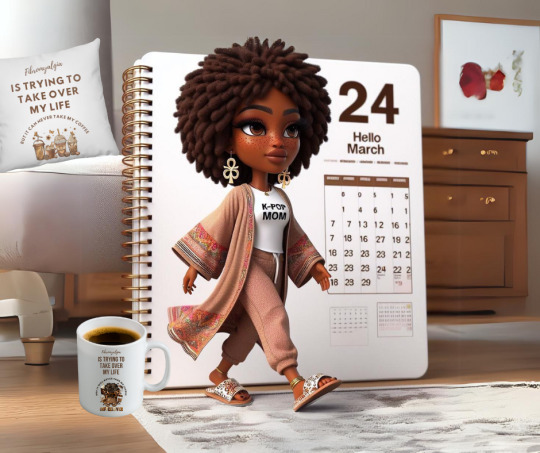
View On WordPress
#Afro-Boho homeschooling#Afrocentric educational activities#Ancestral wisdom in education#Breaking generational curses through homeschooling#Building generational knowledge in homeschool#Chakra-based learning for kids#Cultural homeschool curriculum#Customizable homeschooling templates#Daily homeschool worksheets#Educational worksheets for diverse families#Empowering homeschool lesson plans#Heritage-centered teaching materials#Holistic education printables#Homeschool organization and planning#Homeschooling for black families#Homeschooling with fibromyalgia#Integrating astrology in education#Melaninated homeschool resources#Mindful parenting and education#Yoga and mindfulness for students
1 note
·
View note
Text
People who ask others their pronouns are often ill prepared to cope with people answering with anything outside the anticipated answers -- he, she, OR they, and often having already decided on one (or a lot of times it isn't even a question asked in good faith, rather box checking and virtue flagging).
Being a good ally is not asking someone their pronouns and going oh you're nb, they/them. It's taking whatever the fuck comes out of the other person's mouth and respecting it.
Sorry babe but if me saying I use "any and all" pronouns stresses you out, that's honestly a you problem. It's not my job to pick a "true" or "most preferred" pronoun for you to call me by when my preference is, in fact, use everything chaotically and change it up often.
If you want to ask for clarification on how I'd like various pronouns used, that's fine. But saying to my face "ah I always get stressed about any pronouns - what do I call you"? Just rude tbh. I told you my preference, figure it out. It/they/he/she/xe/zir/fae/rat/bitch/ass/motherfucker I don't care, it's not my problem.
#ally#woke#thats not a question i feel comfortable answering or like to answer or something#oh im gonna teach this person a lesson#its not a trick#one of our professors is aggressively ish and forced me to announce my pronouns in a meeting one time. i said any pronouns.#she didnt know what to do with that. referred to me exclusively by she/her which is fine but then repeatedly referred to me as a woman...#had a conversation about how i dont think asking people their pronouns in a professional setting is a bad form of allyship.#she not even an hour later asked my pronouns. to any pronouns she went ...oh very uncomfortably and referred to me as she/her exclusively#both of which btw are cishet women who very proudly and publicly flaunt how good of allies they are and take diversity related positions#oh btw if it wasnt clear i go to professional school at a uc#so im surrounded by a lot of allies who always think they know best for the marginalized groups they decide to speak for#but also there is a lot of rampant transphobia especially amongst our faculty which are an active threat to trans students#all of course under a veneer of good allyship and caring about our marginalized populations#so one last story#i work a lot of access to care clinics. one of which they do icebreakers and we have to introduce our partner yada yada#partner asks my pronouns. to which i reply bc well no#there are a lot of faculty involved. a lot of students. a lot of people i neither know nor trust nor need to know that about me.#its not like they should refer to me by pronouns anyways. there are over 30 students there thats vague as shit.#anyways. idk what kinda stick they (bc they asked for me to use they/them and unlike them i am not a giant sack of dicks) had up their ass#but they did. so instead of respecting that or asking me to clarify. they announce to the group that i go by any pronouns#which while not untrue. what the ever living fuck. a fucking queer person whose pronouns i respected made a purposeful effort to misgender#me and get others to misgender me bc as a queer person surrounded by strangers and strange faculty a lot of whom i know are transphobes#underneath all their good ranbow flag bullshit#and i didnt feel safe. so rather than try to talk to me they went#which also rhe people at the clinic who do know me didnt blink an eye because *i genuinely do use any pronouns*#so yeah. fuck bad fake allyship. fuck young queers with sticks up their asses and narrow minded tunnel vision views of the world.#being a good ally isnt about interrogating people on their identity#its about accepting it at face value#my identity does not exist as a learning experience for you. it does not have to be within your grasp or comprehension.
15K notes
·
View notes
Text
incredible updates regarding mohamed al manasra's campaign:
mohamed's gofundme page is finally back online after weeks of a technicality preventing him from initiating transfers! please donate and share as widely as possible! family and friend group chats, phone calls, and emails are some of the best ways to get eyes on this campaign!
another update: mohamed's wife, manal, now has an ally at al-shifa hospital who is willing to vouch for her at the border crossing so that she can get into egypt for proper cancer treatment. this is miraculous news, and hugely increases chances of survival for the entire family. manal's friend at al-shifa predicts that he will be able to move manal out of gaza within a month (around the 2025 new year). it is now more important than ever that mohamed's campaign circulate as far as possible. we need these donations to make sure mohamed, manal, and all three of their children can make it past the rafah crossing. the stars have aligned for this family, and it is now our job to get them the funds they need to escape the gaza strip. here are alternative app links that go directly to mohamed's fundraiser organizer. we believe that a diversity of platform options is our smartest strategy going forward, so mohamed may still collect donations when one platform stalls or fails:
cashapp link (for americans)
venmo link (for americans - please do not indicate anything having to do with palestine in description)
paypal link (note: people have been having issues with this link and it’s not clear if it’s just a general issue with paypal or not. i’m leaving it up for now but thankfully the GFM is working again anyway)
mohamed’s fundraiser is vetted #192 here! please help my dear friend. god bless you who are generous and brave for this family that i love so much.
tagging for reach: @transmutationisms @anneemay @determinate-negation @shivroy @teethburied @schoolhater
855 notes
·
View notes
Text
Hey so can we like stop with the "Zutara is for the girls and Kataang is for the boys" thing. It's silly and it's breakdancing just on the edge of gender essentialism.
The assumption that there is something inherent to Zutara that appeals predominantly to women and Kataang that appeals predominantly to men is dishonest because every ship can have appeal to all genders.
The discussion of the "female gaze" in Zutara and the "male gaze" in Kataang is also redundant. I enjoy dissecting the concept of "the gaze", however it is important to note that the "female gaze" doesn't have a set definition or grouping of conventions it adheres to. Lisa French, Dean of RMIT University’s School of Media and Communication says:
“The female gaze is not homogeneous, singular or monolithic, and it will necessarily take many forms... The aesthetic approaches, experiences and films of women directors are as diverse as their individual life situations and the cultures in which they live. The "female' gaze” is not intended here'to denote a singular concept. There' are many gazes."
Now excuse me as I put on my pretentious humanistics student hat.
Kataang's appeal to women and the female gaze
Before I start, I want to note that the female gaze is still a developing concept
There are very few female film directors and writers, and most of them are white. The wants and desires of women of colour, the demographic Katara falls into, are still wildly underepresented. Additionally, the concept of the female gaze had many facets, due to it being more focused on emotional connections rather than physical appearance as the male gaze usually is. Which means that multiple male archetypes fall into the category of "for the female gaze".
The "female gaze" can be best described as a response to the "male gaze", which was first introduced by Laura Mulvey in her paper: "Visual Pleasure and Narrative Cinema" , however the term "male gaze" itself was not used in the paper.
Mulvey brought up the concept of the female character and form as the passive, objectified subject to the active voyeuristic male gaze, which the audience is encouraged to identify, usually through the male character.
To quote her:
"In a world ordered by sexual imbalance', pleasure' in looking has been split between active'/male' and passive/female'. The determining male gaze' projects its fantasy onto the female' figure', which is styled accordingly."
Mulvey also brings up the concept of scopopfillia (the term being introduced by Freud), the concept of deriving sexual gratification from both looking and being looked at. This concept has strong overtones of voyeurism, exhibitionism and narcissism, placing forth the idea that these overtones are what keeps the male viewer invested. That he is able to project onto the male character, therefore being also able to possess the passive female love interest.
However, it's important to note that Mulvey's essay is very much a product of its times, focused on the white, heterosexual and cisgender cinema of her time. She also drew a lot of inspiration from Freud's questionable work, including ye ole penis envy. Mulvey's paper was groundbreaking at the time, but we can't ignore how it reinforces the gender binary and of course doesn't touch on the way POC, particularly women of colour are represented in film.
In her paper, Mulvey fails to consider anyone who isn't a white, cis, heterosexual man or woman. With how underrepresented voices of minorities already are both in media and everyday life, this is something that we need to remember and strive to correct.
Additionally Mulvey often falls into gender essentialism, which I previously mentioned at the beginning of this post. Funny how that keeps coming up
"Visual Pleasure and Narrative Cinema" started a very interesting and important conversation, and I will still be drawing from certain parts of it, however huge swathes of this text have already become near archaic, as our culture and relationship with media evolves at an incredible pace.
And as filmaking evolves, so does our definition of the male and female gaze. So let's see what contemporary filmakers say of it.
In 2016, in her speech during the Toronto International Film Festival , producer of the TV series Transparent, Jill Soloway says:
“Numero uno, I think the Female Gaze is a way of “feeling seeing”. It could be thought of as a subjective camera that attempts to get inside the protagonist, especially when the protagonist is not a Chismale. It uses the frame to share and evoke a feeling of being in feeling, rather than seeing – the characters. I take the camera and I say, hey, audience, I’m not just showing you this thing, I want you to really feel with me.
[Chismale is Soloway's nickname for cis males btw]
So the term "female gaze" is a bit of a misnomer, since it aims to focus on capturing the feelings of characters of all genders. It's becoming more of a new way of telling stories in film, rather than a way to cater to what white, cisgender, heterosexual women might find attractive in a man.
Now, Aang is the decided protagonist of the show, however, Atla having somewhat of an ensemble cast leads to the perspective shifting between different characters.
In the first episode of atla, we very much see Katara's perspective of Aang. She sees him trapped in the iceberg, and we immediately see her altruism and headstrong nature. After she frees Aang, we are very much first subjected to Katara's first impressions of him, as we are introduced to his character. We only see a sliver of Aang's perspective of her, Katara being the first thing he sees upon waking up.
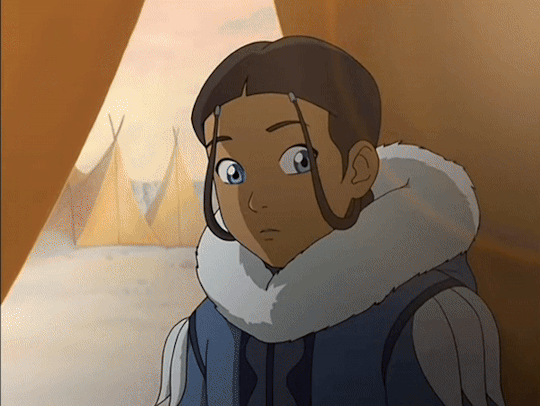
We see that she is intrigued and curious of him, and very excited about his presence. She is endeared and amused by his antics. She is rediscovering her childish side with his help. She is confiding in him about her own trauma surrounding the Fire Nation's genocide of the Southern Waterbenders. She is willing to go against her family and tribe ans leave them behind to go to the Northern Water Tribe with Aang. We also see her determination to save him when he is captured.
As the show moves on and the plot kicks into gear, we do shift more into Aang's perspective. We see his physical attraction to her, and while we don't see Katara's attraction quite as blatantly, there are hints of her interest in his appearance.

This is where we get deeper into the concept of Aang and Katara's mutual interest and attraction for one another. While her perspective is more subtle than most would like, Katara is not purely an object of Aang's desire, no more than he is purely an object of her desire.
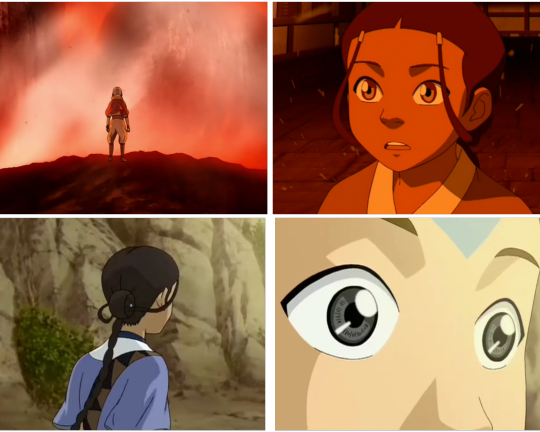
When analysing this aspect of Katara and Aang's relationship, I couldn't help but be reminded of how Célene Sciamma's Portrait of a lady on fire (in my personal opinion, one of the best studies of the female gaze ever created) builds up its romance, and how it places a strong emphasis on the mutuality of the female gaze.
Portrait of a lady on fire's cinematography is very important to the film. We see the world through the perspective of our protagonist, a painter named Marianne. We also see her love interest, Héloïse, the woman whom she is hired to paint a portrait of, through Marianne's lense.
We see Marianne analyse Héloïse's appearance, her beauty. We look purely through Marianne's eyes at Héloïse for a good part of the movie, but then, something unexpected happens. Héloïse looks back. At Marianne, therefore, in some way, also at the audience. While Marianne was studying Héloïse, Héloïse was studying Marianne.
We never shift into Héloïse's perspective, but we see and understand that she is looking back at us. Not only through her words, when she for example comments on Marianne's mannerisms or behaviours, but also hugely through cinematography and acting of the two amazing leads. (Noémie Merlant as Marianne and Adèle Haenel as Héloïse. They truly went above and beyond with their performances.)
This is a huge aspect of the female gaze's implementation in the film. The camera focuses on facial expressions, eyes and body language, seeking to convey the characters' emotions and feelings. There's a focus on intense, longing and reciprocated eye contact (I have dubbed this the Female Gays Gaze.). The characters stand, sit or lay facing each other, and the camera rarely frames one of them as taller than the other, which would cause a sense of power imbalance.
The best way to describe this method of flimaking is wanting the audience to see the characters, rather than to simply look at them. Sciamma wants us to empathise, wants us to feel what they are feeling, rather than view them from a distance. They are to be people, characters, rather than objects.
Avatar, of course, doesn't display the stunning and thoughtful cinematography of Portrait of a Lady on Fire, and Katara and Aang's relationship, while incredibly important, is only a part of the story rather than the focus of it.
However, the 'Kataang moments' we are privy to often follow a similar convention to the ones between Marianne and Héloïse that I mentioned prior.
Theres a lot of shots of Katara and Aang facing each other, close ups on their faces, particularly eyes, as they gaze at one another.
Katara and Aang are often posited as on equal grounds, the camera not framing either of them as much taller and therefore more powerful or important than the other. Aang is actually physically shorter than Katara, which flies in the face in usual conventions of the male fantasy. (I will get to Aang under the male gaze later in this essay)
And even in scenes when Aang is physically shown as above Katara, particularly when he's in the Avatar state, Katara is the one to pull him down, maintaining their relationships as equals.
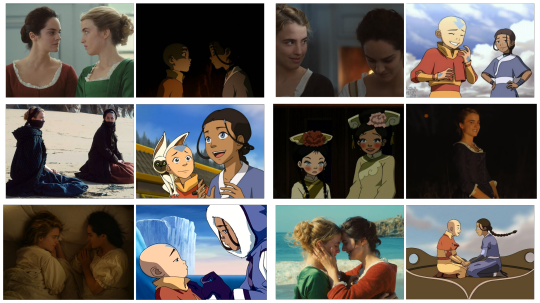
Despite most of the show being portrayed through Aang's eyes, Katara is not a passive object for his gaze, and therefore our gaze, to rest upon. Katara is expressive, and animated. As an audience, we are made aware that Katara has her own perspective. We are invited to take part in it and try to understand it.
Not unlike to Portrait of a Lady on Fire, there is a lot of focus placed on mannerisms and body language, an obvious example being Katara often playing with her hair around Aang, telegraphing a shy or flustered state. We also see her express jealousy over Aang, her face becoming sour, brows furrowed. On one occasion she even blew a raspberry, very clearly showing us, the audience, her displeasure with the idea of Aang getting attention from other girls.
Once again, this proves that Katara is not a passive participant in her own relationship, we are very clealry shown her perspective of Aang. Most of the scenes that hint at her and Aang's focus on their shared emotions, rather than, for example, Katara's beauty.
Even when a scene does highlight her physical appearance, it is not devoid of her own thoughts and emotions. The best example of this being the scene before the party in Ba Sing Se where we see Katara's looking snazzy in her outfit. Aang compliments her and Katara doesn't react passively, we see the unabashed joy light up her face, we can tell what she thinks of Aang's comment.
In fact, the first moment between Katara and Aang sets this tone of mutual gaze almost perfectly. Aang opens his eyes, and looks at Katara. Katara looks back.
There is, once again, huge focus on their eyes in this scene, the movement of Aang's eyelids right before they open draws out attention to that part of his face. When the camera shows us Katara, is zooms in onto her expression as it changes, her blinking also drawing attention to her wide and expressive eyes.

This will not be the first time emphasis is placed on Katara and Aang's mutual gaze during a pivotal moment in the show. Two examples off the top of my head would be the Ends of B2 and B3 respevtively. When Katara brings Aang back to life, paralleling the first time they laid eyes on one another. And at the end of the show, where their gaze has a different meaning behind it.
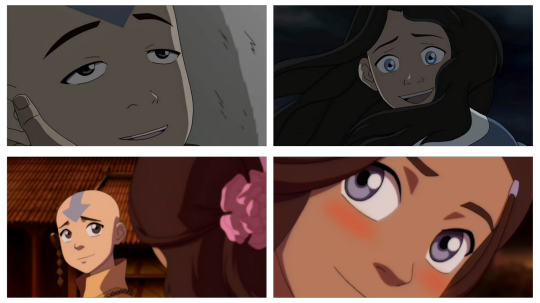
We see Katara's emotions and her intent telegraphed clearly in these instances.
In Book 1, we see her worry for this strange bald boy who fell out of an iceberg, which melts away to relief and a hint of curiosity once she ascertains that he isn't dead.
In B2 we once again see worry, but this time it's more frantic. Her relationship with Aang is much dearer to her heart now, and he is in much worse shape. When we see the relief on her face this time, it manifests in a broad smile, rather than a small grin. We can clearly grasp that her feelings for Aang have evolved.
In B3, we step away from the rule because Aang isn't on the verge of death or unconsciousness for the first time. It is also the first time in a situation like this that Aang isn't seeing Katara from below, but they are on equal footing. I attribute this to symbolising change of pace for their relationship.
The biggest obstacle in the development of Katara and Aang's romance was the war, which endangered both their lives. Due to this, there was a hesitance to start their relationship. In previous scenes that focused this much on Aang and Katara's mutual gaze, Aang was always in a near dead, or at least 'dead adjacent' position. This is is a very harsh reminder that he may very well die in the war, and the reason Katara, who has already endured great loss, is hesitant to allow her love for him to be made... corporeal.
However, now Aang is standing, portraying that the possibily of Katara losing him has been reduced greatly with the coming of peace, the greatest obstacle has been removed, and Katara is the one to initiate this kiss.
Concurrently, Katara's expression here does not portray worry or relief at all, because she has no need to be worried or relieved. No, Katara is blushing, looking directly at Aang with an expression that can be described as a knowing smile. I'd argue that this description is accurate, because Katara knows that she is about to finally kiss the boy she loves.
Ultimately, Katara is the one who initiates the kiss that actually begins her and Aang's romantic relationship.
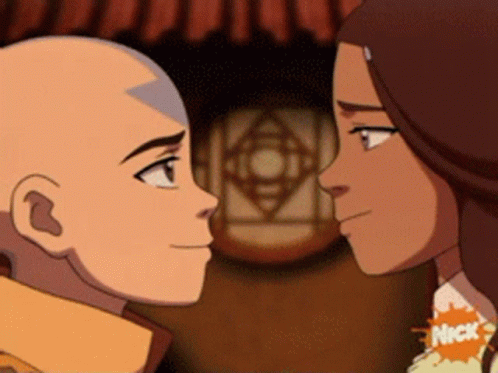
Kataang's appeal to women is reflected in how Katara is almost always the one to initiate physical affection with Aang. With only 3 exceptions, one of which, the Ember Island kiss being immediately shown by the narrative as wrong, and another being a daydream due to Aang's sleep deptivation. The first moment of outwardly romantic affection between Aang and Katara is her kissing his cheek. And their last kiss in the show is also initiated by Katara.
I won't falsely state that Kataang is the perfect representation of the female gaze. Not only because the storyline has its imperfections, as every piece of media has. But also because I simply belive that the concept of the female gaze is too varied and nebulous to be fully expressed. With this essay, I simply wanted to prove that Kataang is most certainly not the embodiment of catering to the male gaze either. In fact it is quite far from that.
The aspects of Kataang that fall more towards embodying the female gaze don't just appeal to women. There's a reason a lot of vocal Kataang shippers you find are queer. The mutual emotional connection between Katara and Aang is something we don't have to identify with, but something we are still able to emphasise with. It's a profound mutual connection that we watch unfold from both perspectives that sort of tracends more physical, gendered aspects of many onscreen romances. You just need to see instead of simply look.
✨️Bonus round✨️
Aang under the gaze
This started off as a simple part of the previous essay, however I decided I wanted to give it it's own focus, due to the whole discourse around Aang being a wish-fullfilling self insert for Bryke or for men in genral. I always found this baffling considering how utterly... unappealing Aang is to the male gaze.
It may surprise some of you that men are also subjected to the male gaze. Now sadly, this has nothing to do with the male gaze of the male gays. No, when male characters, usually the male protagonist, are created to cater to the male gaze, they aren't portrayed as sexually desirable passive objects, but they embody the active/masculine aide of the binary Laura Mulvey spoke of in the quote I shared at the beginning of this essay.
The protagonist under the male gaze is not the object of desire but rather a character men and boys would desire to be.
They're usually the pinnacle of traditional, stereotypical masculinity.
Appearance wise: muscular but too broad, chiseled facial features, smouldering eyes, depending on the genre wearing something classy or some manner of armour.
Personalitywise they may vary from the cool, suave James Bond type, or a more hotblooded forceful "Alpha male" type. However these are minor differences in the grand scheme of things. The basis is that this protagonist embodies some manner of idealised man. He's strong, decisive, domineering, in control, intimidating... you get the gist. Watch nearly any action movie. There's also a strong focus placed on having sway or power over others. Often men for the male gaze are presented as wealthy, having power and status. Studies (that were proved to be flawed in the way the data was gathered, I believe) say that womem value resources in potential male partners, so it's not surprising that the ideal man has something many believe would attract "mates". [Ew I hated saying that].
Alright, now let's see how Aang holds up to these standards.

Well... um...
Aang does have power, he is the Avatar. However, he is often actually ignored, blown off and otherwise dismissed, either due to his age or his personality and ideals being seen as unrealistic and foolish. Additionally, Aang, as a member of a culture lost a century ago, is also often posited as an outsider, singled out as weak, his beliefs touted as the reason his people died out and.
Physically, Aang doesn't look like the male protagonist archetype, either. He isn't your average late teens to brushing up against middle aged. Aang is very much a child and this is reflected in his soft round features, large eyes and short, less built body. This is not a build most men would aspire to. Now, he still has incredible physical prowess, due to his bending. But I'm not sure how many men are desperate to achieve the "pacifist 12 year old" build to attract women.
Hailing from a nation that had quite an egalitarian system, Aang wouldn't have conventional ideas surrounding leadership, even if he does step up into it later. He also has little in the way of possessions, by choice.
As for Aang's personality, well...

I mean I wouldn't exactly call him your average James Bond or superhero. Aang is mainly characterised through his kindness, empathy, cheerful nature and occasional childishness (which slowly is drained as the trauma intesifies. yay.)
Aang is very unwilling to initiate violence, which sets him aside from many other male protagonists of his era, who were champing at the bit to kick some ass. He values nature, art, dance and fun. He's in tune with his emotions. He tries to desecalate situations before he starts a fight.
Some would say many of Aang's qualities could be classified as feminine. While the other main male characters, Zuko and Sokka try to embody their respective concepts of the ideal man (tied to their fathers), Aang seems content with how he presents and acts. He feels no need to perform masculinity as many men do, choosing to be true to his emotions and feelings.
These "feminine" qualities often attract ridicule from other within the show. He is emasculated or infantiliased as a form of mockery multiple times, the most notable examples being the Ember Island play and Ozai tauntingly referring to him as a "little boy". Hell, even certain Aang haters have participated in this, for example saying that he looks like a bald lesbian.
I'd even argue that, in his relationships with other characters, Aang often represents the passive/feminine. Especially towards Zuko, Aang takes on an almost objectified role of a trophy that can be used to purchase Ozai's love. [Zuko's dehumanisation of others needs to be discussed later, but it isn't surprising with how he was raised and a huge part of his arc is steerring away from that way of thinking.]
Aang and Zuko almost embody certain streotypes about relationships, the forceful, more masculine being a literal pursuer, and the gentler, more feminine being pusued.
We often see Aang framed from Zuko's perspective, creating something akin to the mutual gaze of Katara and Aang, hinting at the potential of Zuko and Aang becoming friends, a concept that is then voiced explicitly in The Blue Spirit.
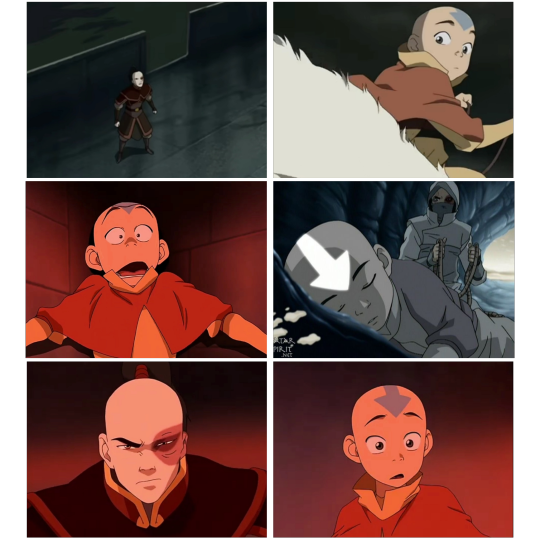
However, unlike Katara, Zuko is unable to empathise with Aang at first, still seeing Aang as more of an object than a person. We have here an interesting imbalance of Aang seeing Zuko but Zuko meerly looking at Aang.
There is a certain aspect of queer metaphor to Zuko's pursuit of Aang, but I fear I've gotten off topic.
Wrapping this long essay up, I want to reiterate that I'm not saying that Zutara isn't popular with women. Most Zutara shippers I've encountered are women. And most Kataang shippers I've encountered are... also women. Because fandom spaces are occupied predominantly by women.
I'm not exactly making a moral judgement on any shippers either, or to point at Kataang and go: "oh, look girls can like this too. Stop shipping Zutara and come ship this instead."
I want to point out that the juxtaposition of Zutara and Kataang as respectively appealing to the feminine and masculine, is a flawed endeavour because neither ship does this fully.
The concept of Kataang being a purely male fantasy is also flawed due to the points I've outlied in this post.
Are there going to be male Kataang shippers who self insert onto Aang and use it for wish fulfilment? Probably. Are there going to be male Zutara shippers who do the same? Also probably.
In the end, our interpretation of media, particularly visual mediums like film are heavily influenced by our own biases, interests, beliefs andmost importantly our... well, our gaze. The creators can try to steer us with meaningful shots and voiced thought, directing actors or animating a scene to be a certain way, but ultimately we all inevitably draw our own conclusions.
A fan of Zutara can argue that Kataang is the epitome of catering to the male gaze, while Zutara is the answer to women everywhere's wishes.
While I can just as easily argue the exact opposite.
It really is just a matter of interpretation. What is really interesting, is what our gaze says about us. What we can see of ourselves when the subject gazes back at us.
I may want to analyse how Zutara caters to the male gaze in some instances, if those of you who manage to slog through this essay enjoy the subject matter.
#ok getting off my soapbox#i forgot how much i love to write these long sprawling essays...#kataang#pro kataang#aang#pro aang#aanglove#aang defense squad#pro katara#katara defense squad#kataang love#zuko#avatar#atla#avatar: the last airbender#the last airbender#avatar the last airbender#aang the last airbender#anti zutara
411 notes
·
View notes
Text
education vs. fascism in iruma-kun
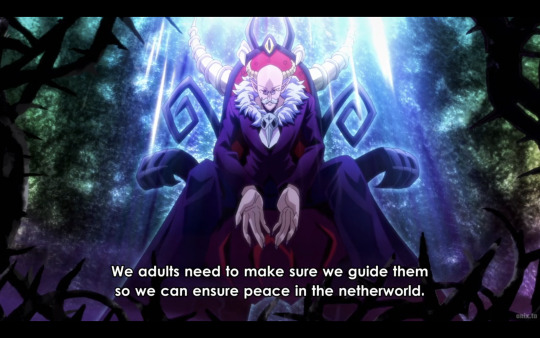
someone mentioned this in another post but iruma-kun does a wonderful job of showing that education is key to fighting fascist and harmful radical ideas. As soon as it became clear that things were going to change in the netherworld what was Sullivan's response? It wasn't "oh we need to send spies" or "we need to find the people" (though im sure people are working hard to find those answers) it was "we need to focus on educating our students." Because only knowledge and diversity in thoughts can combat fascist ideas. The issue only becomes worse with a lack of understanding and an echo chamber. And by doubling down with education, we can make sure our students are prepared for what lies ahead. Thats how we truly fight the power.
The teachers themselves can tell that things are changing. They stay informed and guess what? its obvious things are about to throw down soon. And so they work tirelessly not just because it's their jobs, but because they need to. this is their protest. this is how we can prevent the spread of gross rhetoric. And after Heartbreaker what they do? they double down on their education too. Because there is always something new to learn, always a way to grow/sharpen your strength. They too know that they can't stay stagnant, they must continue pushing to provide their students with the best chance of survival.
When you have villians that believe in these ideas in media, there's a big issue of them leaving out education as a weapon. But it's crucial if we want anything to truly change. Iruma himself wants to no longer be naive about the netherworld which was growing to be an issue the longer he stays. because yeah, you can't stay uninformed anymore iruma. its time to learn about the history of you new home and the leaders. taking being the king out of it, ignorance about these topics is a breeding ground for becoming complacent. iruma wants to be a hero? or at least, do the right thing when he can? that requires knowledge to make sure you aren't inadvertently hurting someone along the way.
Iruma loves the netherworld, the place he proudly calls home. but it's frought with danger and cruel people. And yet, Iruma is still proud of his new home and friends and wants to do anything he can to stay here. This reflects real life, where there is goodness and pride in the place you live and yet a faction of people who taint it with othering ideas. However, it's always worth fighting for the good overall and bettering yourself so you can see another tomorrow through. Iruma knows he can only protect himself and his loved ones is through learning. And I love Nishi for truly understanding this too. You can't fight fascism through pure will, it has to be beaten by education and the williness to better one's knowledge. That is how we will take back the Netherworld.
but yeah, this is just my little spiel as someone who loves educational activism and is going to school to become a teacher :). If i can find the original post I'll make sure to credit the op!
#iruma-kun#mairimashita! iruma kun#welcome to demon school iruma kun#m!ik#mairuma#i had a different post planned but it wasn't done so enjoy this short one instead!
889 notes
·
View notes
Text

Via NasAlSudan
Learn about the Sudanese revolution, the significance of December 19, and a legacy of resistance and resilience.
Join our call to action today and everyday during Sudan Action Week.
December 19 2023
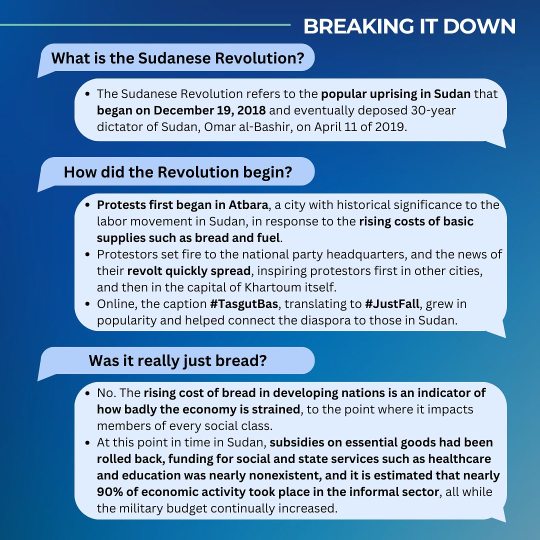
Transcript:
Breaking it down
What is the Sudanese Revolution?
The Sudanese Revolution refers to the popular uprising in Sudan that began on December 19, 2018 and eventually deposed 30-year dictator of Sudan, Omar al-Bashir, on April 11 of 2019.
How did the Revolution begin?
Protests first began in Atbara, a city with historical significance to the labor movement in Sudan, in response to the rising costs of basic supplies such as bread and fuel.
Protestors set fire to the national party headquarters, and the news of their revolt quickly spread, inspiring protestors first in other cities, and then in the capital of Khartoum itself.
Online, the caption #TasgutBas, translating to #JustFall, grew in popularity and helped connect the diaspora to those in Sudan.
Was it really just bread?
No. The rising cost of bread in developing nations is an indicator of how badly the economy is strained, to the point where it impacts members of every social class.
At this point in time in Sudan, subsidies on essential goods had been rolled back, funding for social and state services such as healthcare and education was nearly nonexistent, and it is estimated that nearly 90% of economic activity took place in the informal sector, all while the military budget continually increased.
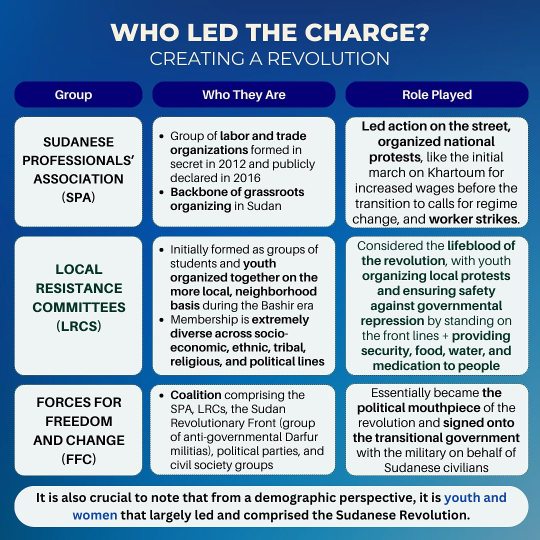
Transcript:
Who led the charge? Creating a revolution
Group: Sudanese Professional's association (SPA)
Who they are:
Group of labor and trade organizations formed in secret in 2012 and publicly declared in 2016
Backbone of grassroots organizing in Sudan
Role played:
Led action on the street, organized national protests, like the initial march on Khartoum for increased wages before the transition to calls for regime change, and worker strikes.
Group: Local Resistance Committees (LRCS)
Who they are:
Initially formed as groups of students and youth organized together on the more local, neighbourhood basis during the Bashir era
Membership is extremely diverse across socio-economic, ethnic, tribal, religious, and political lines
Role played:
Considered the lifeblood of the revolution, with youth organizing local protests and ensuring safety against governmental repression by standing on the front lines + providing security, food, water, and medication to people
Group: Forces for freedom and change (FFC)
Who they are:
Coalition comprising the SPA, LRCS, the Sudan Revolutionary Front (group of anti-governmental Darfur militias), political parties, and civil society groups
Role played:
Essentially became the political mouthpiece of the revolution and signed onto the transitional government with the military on behalf of Sudanese civilians
It is also crucial to note that from a demographic perspective, it is youth and women that largely led and comprised the Sudanese Revolution.
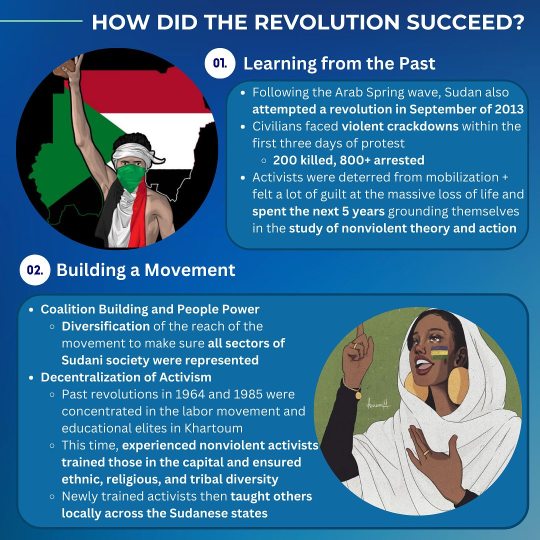
Trabscript:
How did the revolution succeed?
01. Learning from the Past
Following the Arab Spring wave, Sudan also attempted a revolution in September of 2013
Civilians faced violent crackdowns within the first three days of protest. 200 killed, 800+ arrested
Activists were deterred from mobilization + felt a lot of guilt at the massive loss of life and spent the next 5 years grounding themselves in the study of nonviolent theory and action
02. Building a Movement
Coalition Building and People Power
Diversification of the reach of the movement to make sure all sectors of Sudani society were represented
Decentralization of Activism
Past revolutions in 1964 and 1985 were concentrated in the labor movement and educational elites in Khartoum
This time, experienced nonviolent activists trained those in the capital and ensured ethnic, religious, and tribal diversity
Newly trained activists then taught others locally across the Sudanese states
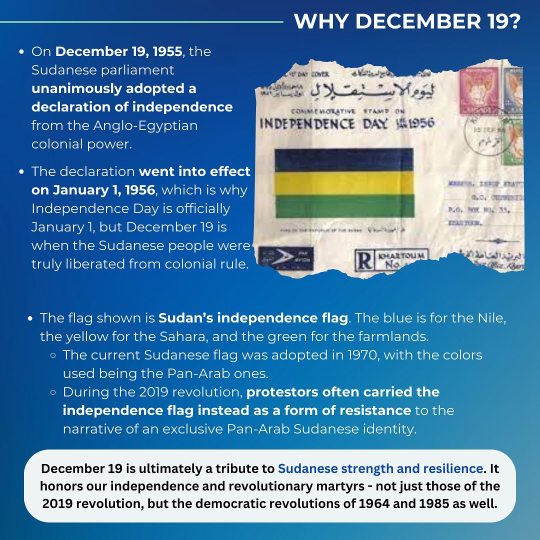
Transcript:
Why december 19?
On December 19, 1955, the Sudanese parliament unanimously adopted a declaration of independence from the Anglo-Egyptian colonial power.
The declaration went into effect on January 1, 1956, which is why Independence Day is officially January 1, but December 19 is when the Sudanese people were truly liberated from colonial rule.
The flag shown is Sudan's independence flag. The blue is for the Nile, the yellow for the Sahara, and the green for the farmlands.
The current Sudanese flag was adopted in 1970, with the colors used being the Pan-Arab ones.
During the 2019 revolution, protestors often carried the independence flag instead as a form of resistance to the narrative of an exclusive Pan-Arab Sudanese identity.
December 19 is ultimately a tribute to Sudanese strength and resilience. It honors our independence and revolutionary martyrs - not just those of the 2019 revolution, but the democratic revolutions of 1964 and 1985 as well.
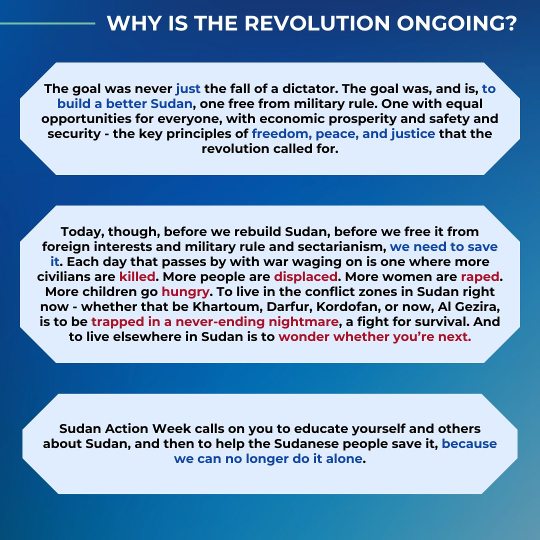
Transcript:
Why is the revolution ongoing?
The goal was never just the fall of a dictator. The goal was, and is, to build a better Sudan, one free from military rule. One with equal opportunities for everyone, with economic prosperity and safety and security - the key principles of freedom, peace, and justice that the revolution called for.
Today, though, before we rebuild Sudan, before we free it from foreign interests and military rule and sectarianism, we need to save it. Each day that passes by with war waging on is one where more civilians are killed. More people are displaced. More women are raped. More children go hungry. To live in the conflict zones in Sudan right now - whether that be Khartoum, Darfur, Kordofan, or now, Al Gezira, is to be trapped in a never-ending nightmare, a fight for survival. And to live elsewhere in Sudan is to wonder whether you're next.
Sudan Action Week calls on you to educate yourself and others about Sudan, and then to help the Sudanese people save it, because we can no longer do it alone.

Transcript:
What can you do? Uniting for Al Gezira and North Darfur
As we witness the unfolding events in Al Gezira and North Darfur, the communities of Abu Haraz, Hantoub, Medani, El Fasher, and many others are reaching out for assistance. Sudanese resilience persists to this day, with individuals on platforms like Facebook, Twitter, Instagram, and TikTok seeking and providing guidance on transportation services, medical care, food, shelter, protection, safe zones, operational markets, and more. This isn't new for the Sudanese community. A legacy of unity emerged, notably during the 2019 revolutions, where nas al Sudan [the people of Sudan], both within the nation and in the diaspora, rallied together to support each other online. Beyond merely sharing stories on social media, this was about strengthening collective action, enhancing mobilizations, and building a resilient community rooted in solidarity. The essence of the Sudanese community lies in people supporting people, notably during the uprising in 2018 and following the events of April 15th, 2023
Swipe to see how you can help.
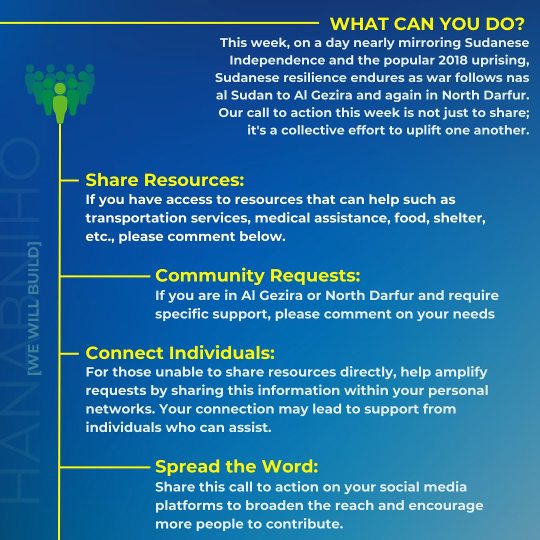
Transcript:
What can you do?
This week, on a day nearly mirroring Sudanese Independence and the popular 2018 uprising, Sudanese resilience endures as war follows nas al Sudan to Al Gezira and again in North Darfur. Our call to action this week is not just to share; it's a collective effort to uplift one another.
Share Resources:
If you have access to resources that can help such as transportation services, medical assistance, food, shelter, etc., please comment below.
Community Requests:
If you are in Al Gezira or North Darfur and require specific support, please comment on your needs
Connect Individuals:
For those unable to share resources directly, help amplify requests by sharing this information within your personal networks. Your connection may lead to support from individuals who can assist.
Spread the Word:
Share this call to action on your social media platforms to broaden the reach and encourage more people to contribute.
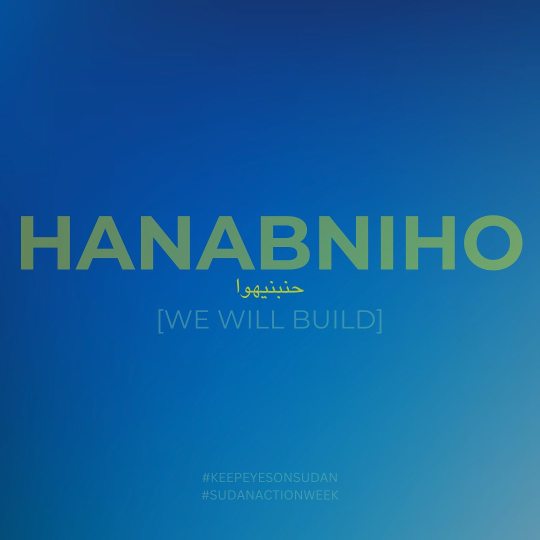
Transcript:
Hanabniho
حنبنيهوا
[We will rebuild]
#keepEyesOnSudan
#SudanActionWeek
924 notes
·
View notes
Text
The University of Michigan’s alleged frustration with local prosecutors stems from a November campus sit-in at which Ann Arbor police arrested a group of 40 protesters. The Washtenaw county prosecutor Eli Savit, a progressive prosecutor who is also Jewish, announced in May that his office would dismiss 36 cases and recommend four for diversion programs where they faced a light punishment.
That incensed U-M’s pro-Israel regents and police department because they wanted swifter, tougher charges, according to sources with knowledge of the process, who spoke with the Guardian on the condition of anonymity. They then asked Nessel to take the cases and university police sent warrant requests to her office.
Multiple legal observers said it is unprecedented for a state attorney general to take protest cases instead of local prosecutors. In September, ACLU Michigan wrote in a statement that it was “especially concerned” the state’s highest law enforcement office was deployed to issue only minor charges, such as misdemeanor trespassing, for some protesters.
[...]
U-M denied wrongdoing, and the university and regent Jordan Acker said it was “not true” that the university asked Nessel to investigate, but rather that Nessel offered to take the cases. He then said the attorney general’s unprecedented involvement in a protest case was justified. “I would say I don’t think we have seen anything like this before either, where you have a coordinated, foreign-funded student protest that is engaging in violent activity,” Acker said. (There is no evidence the encampment received any foreign funding, and students blame reports of any violence that took place when the encampment was cleared on police.)
[...]
Nessel received $25,000 from the Michigan Jewish Democratic caucus, which was founded and is partially funded by state representative Noah Arbit, an outspoken pro-Israel politician, “good friend” of Nessel and frequent critic of pro-Palestinian advocates. He recently labeled student protesters “sick cowards”.
Meanwhile, a Democratic U-M donor and school of information board member who last year faced no consequences after allegedly verbally and physically assaulting Arab American students has, along with her husband who is a university donor, given $26,000 to Nessel.
207 notes
·
View notes
Text

A/N: this small thing drew inspiration from a recent conversation I had with my wonderful @indignant-alpaca, delving into the common struggles faced by students across various disciplines. Despite our diverse fields of study, we all encounter similar challenges sooner or later. Drawing from my own experiences, I decided to craft a variation focused on enhancing the learning process, using one of my favorite characters, Bakugo, as a source of inspiration 💣
MY HERO ACADEMIA MASTERLIST

In class
Be actively involved in class discussions and activities. Katsuki would assertively participate, ensuring he grasps concepts firsthand.
Treat each class as a competition to stay engaged. Challenge yourself to excel, just like Bakugo's competitive spirit drives him to be the best hero.
Don't hesitate to ask questions when you're unclear. Katsuki would demand clarity, and you should too! It's a proactive approach to understanding the material.
Observe and analyze the teacher's explanations and demonstrations. Katsuki assesses his opponents' moves; similarly, analyze the "moves" in your lessons for a deeper understanding.
Take dynamic and concise notes. Katsuki strategizes in the heat of battle, and your notes should capture essential information for later review.
Studying
Approach your study sessions with intensity and focus. Katsuki's training is high-intensity, and your studies should match that energy.
Divide your study time into focused blocks for specific subjects. Master each "arc" before moving on to the next, just like Katsuki hones specific skills.
Work on problem-solving exercises regularly. Katsuki tackles various challenges, and you should too. Practical application reinforces theoretical knowledge.
Utilize interactive study methods. Katsuki learns by doing, and hands-on activities or simulations can enhance your understanding of complex topics.
Plan your study sessions strategically, focusing on high-priority subjects during peak concentration times. This approach mirrors Katsuki's tactical approach to hero battles.
Channel your inner hero by immersing yourself completely in the subject matter, just as Katsuki immerses himself in his battles.
Break down complex topics into smaller components for in-depth understanding, similar to how Katsuki analyzes quirks of his opponents to identify their weaknesses.
Learning attitude
Cultivate a hero's mindset. Set ambitious goals and view your studies as a heroic journey toward self-improvement.
Develop resilience in the face of challenges. Katsuki faces setbacks but emerges stronger. Treat academic difficulties as opportunities for growth.
Believe in your capabilities. Katsuki exudes confidence, and a strong belief in your abilities can positively impact your academic performance.
Be flexible in your approach to learning. Katsuki adapts his fighting style, and similarly, adapt your study techniques to different subjects or challenges.
Regularly reflect on your progress. Katsuki analyzes his battles for improvement; evaluate your academic journey to identify areas for growth.
Learning, Bakugo-style, means embracing the fact that doubters will always exist, no matter your achievements. Instead of seeking external validation, channel that energy into mastering your skills and gaining knowledge for your own growth. The focus should be on personal improvement and the satisfaction that comes from overcoming challenges, rather than proving yourself to others.
Periodically review past material to reinforce your knowledge. Katsuki often reflects on his battles to improve his combat strategy. Apply this concept to your studies for a solid foundation.
Test yourself regularly to identify weak points. Katsuki constantly challenges himself in battles to enhance his abilities. Use quizzes to gauge your progress and strengthen areas where you struggle.
Develop mental resilience to overcome setbacks. Katsuki faces defeats but bounces back stronger. Treat failures as stepping stones, learning from them to improve and move forward.
#bakugo katsuki#study like Bakugo#bakugo#katsuki bakugou#bakugo x reader#kacchan#bakugo headcanons#mha headcanons#bakugou katsuki#bakugo fluff#bakugou katsuki headcanons#bakugou fluff#mha fluff#katsuki bakugo x reader#bakugo x you
526 notes
·
View notes
Text


applying to schools (what to consider)
academic programs: ensure the schools offer strong programs in your areas of interest. there's no point getting into and attending a prestigious school if you're not interested in what you're studying.
location: think about whether you prefer an urban, suburban, or rural setting, and consider the climate and distance from home. distance from home is a big thing if you're still living at home or are not yet in university/college. i'm in tenth grade at the moment and attend a school that is around an hour and a half away from my home - but it's a great school and i enjoy the schooling!
when applying to universities outside of your state/country, research the surrounding areas so that you understand what you're getting yourself into by applying.
size: decide if you want a large university with many resources or a smaller college with a close-knit community. additionally, consider whether you'd like to learn in a fast-paced and busy city or in a more laid-back environment.
cost and financial aid: evaluate tuition costs and the availability of scholarships, grants, and financial aid. if you have the ability to apply for a scholarship/grant, do not waste the opportunity!
campus culture: visit campuses if possible or attend virtual tours to get a feel for the student life and community. this can help you understand whether or not the environment is right for you.
admissions requirements: check the average gpa, test scores, and other requirements to ensure you meet the criteria. - and then bloody work for it! make sure that you are suitable for your dream school. there is no point in researching these things if you will not work to improve them.
extracurricular opportunities: look for clubs, sports, and other activities that interest you, or that you currently participate in. sharing an extracurricular activity with a university/college may give you a talking point for your interview/admissions essay.
career services: consider the support available for internships, job placements, and career counseling.
reputation and rankings: while not the only factor, the school’s reputation and rankings can provide insight into its strengths. check the times higher education site to look at the strengths and weaknesses of your preferred college.
personal preferences: think about what matters most to you, such as diversity, study abroad programs, or specific facilities.
i hope this was helpful! ❤️nene
#becoming that girl#study blog#productivity#chaotic academia#it girl#academia#student life#that girl#student#it girl aesthetic#university#nenelonomh#uni student#uniblr#university student#university of oxford#studying#study#study aesthetic#100 days of studying#study hard#study community#study inspiration#study motivation#study space#study with me#studyabroad#studyblr#study tips#studyblr community
96 notes
·
View notes
Text
Schools in Jamshedpur Celebrate 78th Independence Day with Patriotic Fervor
Students at JP School in Mango perform patriotic songs and dances after flag hoisting, celebrating unity in diversity. Jamshedpur schools marked the 78th Independence Day with enthusiasm, featuring patriotic performances by students. JAMSHEDPUR – The 78th Independence Day was celebrated with great zeal in educational institutions across Jamshedpur, including at JP School in Mango’s Jay Prakash…
#शिक्षा#cultural programs#education#flag hoisting#Independence Day#Jamshedpur#JP School Mango#national pride#patriotic performances#School Celebrations#Student Activities#Unity in Diversity
0 notes
Text
Okay, lets go through this apparent list of positives that Biden is in favor of.
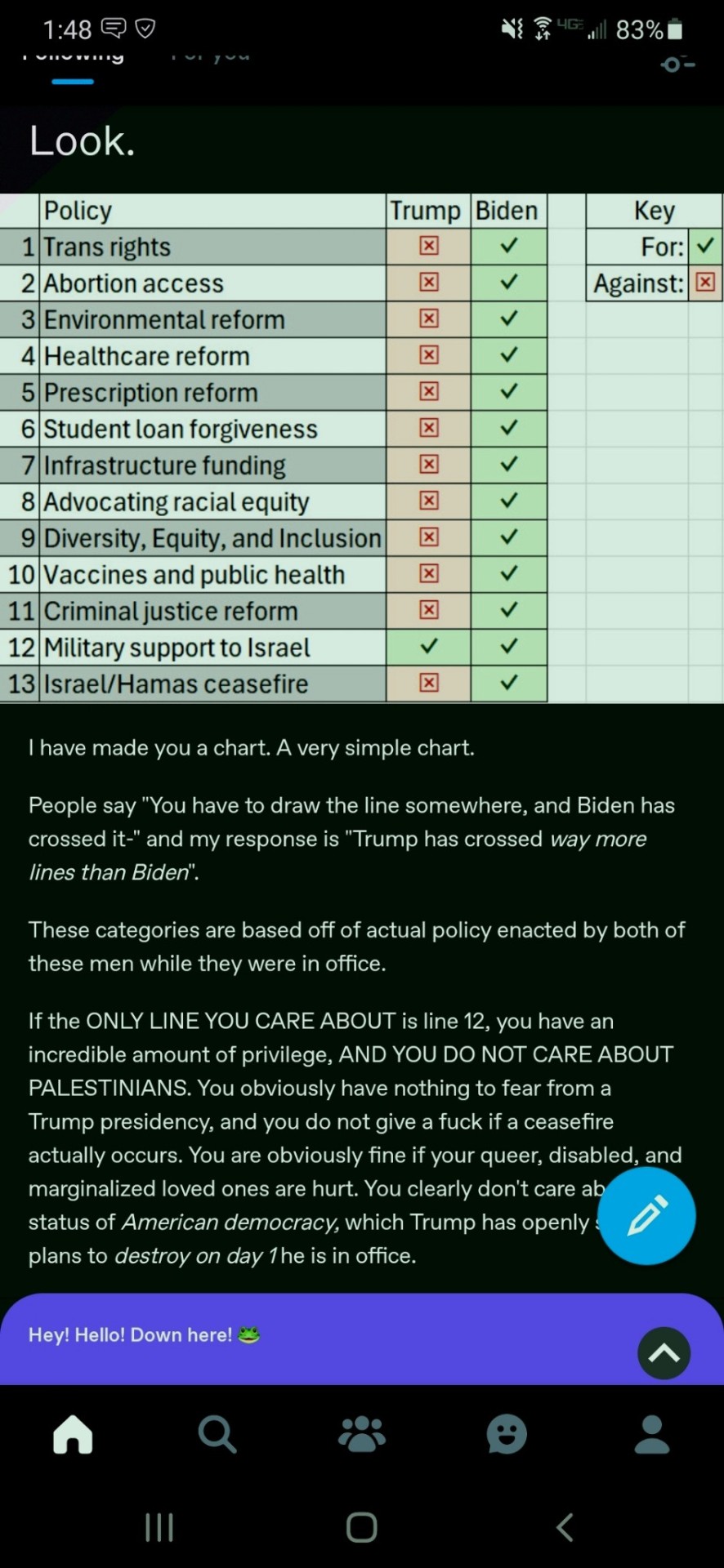
Trans Rights: There have been multiple laws within states to fully close off especially trans kids rights to medical treatments and more. This is extremely current. Biden puts in minimal effort to look like he's doing anything at all for trans and queer rights, and there haven't really been any efforts aside from doing one or two proposals that immediately get shot down, and he's more than okay with that, hence why there's no longer really any push for this shit still. If you're trans, you can't piss in Utah without the risk of getting a fine right now. Even though these are state laws, the fact that there's been nearly zero effort federally to address this besides the title IX rule, speaks a lot about priorities in this area.
Abortion Access: Are we just forgetting the whole Roe V Wade getting overturned thing that happened in 2022? Are you really trying to say that this is good for abortion access? Abortion access has gotten actively worse.
Environmental Reform: Biden has endorsed extreme oil drilling projects and in general oil companies still love him! Not to mention the train crashes which we'll get to later.
Healthcare Reform: Covid-19 is still around and is sadly predicted to stay around for a long while. Healthcare is still private and a competitive field in the US and that causes major issues as well. If you look this up, you see articles titled along the lines of "Biden has lowered the cost of insurance" and meanwhile it just dropped in 2020 once during the pandemic but has been growing in cost.
Prescription Reform: Reading into this, not much has changed, which isn't surprising under genocide Joe. Drugs in the US are still higher than anywhere else in the world, and with healthcare issues still abundant, this is still a big issue.
Student Loan Forgiveness: Student debt is still extremely high in the US, and while Biden has rolled out some plans for forgiveness, it's a fraction of the debt, and he primarily uses the whole thing to win over swing states. This is a dangling carrot that provides very little overall.
Infrastructure Funding: Train crashes from 2020-present, worldwide, but notice the amount of US crashes! Neat! Quite literally just look up train crashes in the US during his presidency, there's too many to link here. It is also important to remember that Biden signed a bill to prevent rail strikes, preventing a lot of pressure to the government and the economy, which would have been a GOOD THING. Seriously, this guy has fucked up our environment and our rights in multiple ways.
Advocating Racial Equity: Structural racism within the US is still a huge problem, Biden hasn't addressed much. Also people are still in cages on the Mexico/US border (Which has been maintained by every president in office since it was established), with a very recent crackdown on the border.
Diversity, Equity, and Inclusion: Just. Look at the racial equity and trans rights sections above. Biden does the bare minimum, loves focusing on swing states, and all around uses the ol' carrot on a stick.
Vaccines and Public Health: Once again look above at sections on healthcare, abortion access, and prescription reform. Its bad. Remember how Covid-19 vaccines aren't being continued for free?
Criminal Justice Reform: This is just structural slavery still. Disproportionate amounts of black people are incarcerated, police are still heavily funded under Biden. He does not care about reforming the justice system, he even supports cops breaking up campus protests! Cool!
Military Support for Israel: Yup! Both sides suck! Biden has a very long history of sure hating Arabic countries though! He's done nothing but ship weapons and participate in the genocide of Palestinian people. Would Trump also do this? Yes. Does this mean this is an issue you should just drop and call a non-issue? No, what the hell are you talking about.
Israel/Hamas Ceasefire: Netanyahu has no plans to accept any actual ceasefire, yet Biden still provides weapons and support. Wow! That sure is weird? I wonder if Biden really cares about a ceasefire or how he just looks publicly.
Biden is not a good president, much less a good human being. You provided such a flimsy chart with zero resources or support behind you, and it just feels like people are just making shit up at this point. Get your heads out of the liberal cesspool you grew up in.
#This one got long#Please feel free to correct me especially in regards to anything concerning foreign policies @ people not from the US#As someone who lives here in the US I don't have the lived experiences that come with this shit nation constantly fucking up the globe#Liberals are unable to imagine a better world#Stop calling Biden some kind of amazing president. He's funding a genocide and has effectively been asleep at best during his time#And been doing much worse while he's actually been doing anything#He is not some sleepy old dude he's a war criminal and a person who has enacted great harm towards many many people
176 notes
·
View notes
Note
Loved your take on cirava :3 think we could see one of the wonderful tired teal that is tyzias?

Gold Rule Tyzias. Tyzias is a member of the student branch of the Sufferer’s Scions, a diverse club of young trolls invested in caste equality. The Gold Rule colonies have always followed the sufferer’s teachings, circulated between helmsman by The Psiioniic—but Sufferers Scions believe more needs to be done. Their current most important issue is statistically disproving the myth of 'highblood rage' and instead showing anger effects all castes equally. They’re also setting up legal protections for limebloods as the caste enters the system, and always working on desegregation. The Scions on the main planet recently broadened jadeblood rights.
Tyzias specifically focuses on attorneys treating clients equally, and modifying certain laws. They work very hard to participate in activism on top of the normal intense workload Tealbloods have, so they're perpetually pretty tired. Their thermos is for keeping hydrated throughout the day, and they also carry leaflets for recruiting new club members and explaining legal changes. Scion members wear highlights of red to represent their cause.
#homestuck#bugstuck#buggy trolls#ask#tyzias#hiveswap tyzias#tyzias entykk#gold rule#frick accidentally posted this early : (#it was supposed to come out in 2 days#ergh can i fix this. no i dont think so#ill just... reblog it again in two days#sorry this one comes early i guess >_< FRICK
168 notes
·
View notes
Text
things I think are responsible for the reading comprehension crisis, rather than the things people always talk about:
people get so worried that kids will hate reading that they profusely compliment any analysis young kids make, even when it's blatantly wrong, like A Modest Proposal levels of wrong. which means later when someone argues they refuse to listen because they think they're perfect at analyzing books
teachers are so overworked and undersupplied (and often assholes) that they demand only a specific version of analysis that they agree with and if anyone has any competing arguments they get their grades docked. possibly due to above
because of the literacy crisis, people keep putting huge, daunting classics in front of kids instead of fun books. this leads kids to believe that books can't be fun. or that books can only be fun if you pretend they have nothing to say
knowing that encouraging reluctant readers in reading literally anything improves literacy, people start encouraging all readers the same way. this leads to kids believing they're super smart and special readers who read way above grade level when they're actually falling seriously behind
the attitude of 'everyone has something worthwhile to say' means that people work really hard to compliment students who say things that are pointless or even fundamentally wrong. while withholding praise from students who make creative contributions in case it seems 'unfair'
that weird thing where kids now believe that everyone has to agree on everything or they're experiencing violence
increased push for diverse perspectives in fiction simultaneous with a push against describing the backgrounds or social situations of various authors (or historical figures in general) means there's less context and more confusion
it seems like people have stopped explaining that you can enjoy something artistically while disagreeing with its message or values? I blame advertisers for this one because it's the thing that lets kids not fall for commercials
too much emphasis on how 'everyone is smart' instead of placing less social import on intelligence. leads to ideas like 'no one can be more talented at anything than anyone else, they only practiced more' which makes more perceptive kids dumb down their analysis so no one thinks they're being stuck up. it also makes people believe no two books could be saying different things
the strong push against TV, movies, video games, etc. being considered art means people no longer bother to analyze them artistically. so they don't exercise the same skills they'd need for reading while doing other things
and the related push that reading is always a 'brainy' activity and all books are 'equally smart', meaning that even books that don't say much must secretly be incredibly complex and have deep, well-researched messages. which leads to people inventing things that aren't there. and since they have nothing to practice on, also no learning how to pick up on things that are there
the idea that there's some inherent divide between 'mindless' activities and 'intellectual' activities, and that it's a trait of the activities themselves, not how people engage with them. so people are under the impression they don't have to try to do anything in particular. it'll just happen
the creepy thing where people universalize history and think everything has always been the same as it is now, only worse (or better, depending) and related misunderstandings
whatever has happened to fact-checking
novels genuinely are worse quality now because there's less money in it and therefore way more constraints on who writes and what they write and how it gets popularized
97 notes
·
View notes
Text
An announcement :D
Hi, guys!
So, a while back I talked about wanting to look for a job at a new school because my current school is shit to teachers and students in general and also doesn't support gender diversity.
I'm SUPER happy to say I found a new job at a school that actively supports gender diversity and LGBTQIA+ students (and it still pays the same, thank god). I'm thankful to all of you for supporting me, because your encouragement really helped <3
Also....I'll be working with middle schoolers for the first time, so if any of you have worked with middle schoolers/have middle school kids/ARE middle schoolers....advice would be lovely! I've only ever worked with kids ages 4-11, so I'm a bit nervous to work with ages 11-15!
119 notes
·
View notes